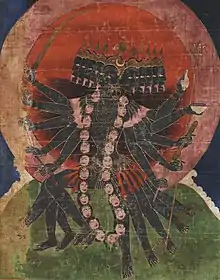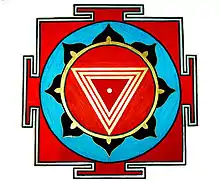Mahakali
Mahakali (Sanskrit: महाकाली, romanized: Mahākālī) is the Hindu goddess of time and death in the goddess-centric tradition of Shaktism.
| Mahakali | |
|---|---|
Mother Goddess Goddess of Time and Death[1] | |
| Member of Mahavidya | |
 Mahakali, National Museum, Delhi | |
| Devanagari | महाकाली |
| Sanskrit transliteration | Mahākālī |
| Affiliation | Parvati, Shaktism, Lakshmi |
| Abode | Manidvipa |
| Mantra | ॐ क्रीं कालिकायै नमः oṁ krīṁ kālikāyai namaḥ |
| Weapon | Dhāl shield, trishul, sword, dagger, akshay patra, bow and arrow, scimitar, cobra, gada, the Vedas, chakram, noose, vajra, conch |
| Consort | Mahakala |
Similar to Kali, Mahakali is a fierce goddess associated with universal power, time, life, death, and both rebirth and liberation. She is the consort of Bhairava, the god of consciousness, the basis of reality and existence. Mahakali, in Sanskrit, is etymologically the feminised variant of Mahakala, or Great Time (which is also interpreted as Death), an epithet of the deities Narasimha and Shiva in Hinduism.
Meaning
Mahakali's origin is contained in various Puranic and Tantric Hindu Scriptures (Shastras). In the texts of Shaktism, she is variously portrayed as the Adi-Shakti, the Primeval Force of the Universe, identical with the Ultimate Reality, or Brahman. She is also known as the (female) Prakriti or World as opposed to the (male) Purusha or Consciousness, or as one of three manifestations of Mahadevi (The Great Goddess) that represent the three Gunas or attributes in Samkhya philosophy. In this interpretation Mahakali represents Tamas or the force of inertia. A common understanding of the Devi Mahatmya ("Greatness of the Goddess") text, a later interpolation into the Markandeya Purana, considered a core text of Shaktism (the branch of Hinduism which considers Durga to be the highest aspect of Godhead), assigns a different form of the Goddess (Mahasaraswati, Mahalakshmi, and Mahakali) to each of the three episodes therein. Here, Mahakali is assigned to the first episode. She is described as an abstract energy, the yoganidra of Vishnu.
Iconography
Mahakali is most often depicted in blue/black complexion in popular Indian art.
Her most common four armed iconographic image shows each hand carrying variously a crescent-shaped sword, a trishul (trident), a severed head of a demon and a bowl or skull-cup (kapala) catching the blood of the severed head. Her eyes are described as red with intoxication and in absolute rage, her hair is shown disheveled, small fangs sometimes protrude out of her mouth and her tongue is lolling. The blood of the demons she slays drips out of her lolling tongue, having consumed it. She is adorned with a garland consisting of the heads of demons she has slaughtered, variously enumerated at 108 (an auspicious number in Hinduism and the number of countable beads on a Japa Mala, similar to a rosary, for repetition of Mantras) or 50, which represents the letters of the Sanskrit alphabet, Devanagari, and wears a skirt made of demon arms.

Her ten headed (dashamukhi) image is known as the 10 Mahavidyas Mahakali, and in this form she is said to represent the ten Mahavidyas or "Great Wisdom (Goddess)s". She is sometimes shown sitting on a flaming grave or a rotting corpse. Her complexion is described as that of the night sky, devoid of stars. She is depicted in this form as having ten heads, thirty flaming eyes, ten arms, and ten legs but otherwise usually conforms to the four armed icon in other respects. Each of her ten hands is carrying an implement which varies in different accounts, but each of these represent the power of one of the devas, and are often the identifying weapon or ritual item of a given Deva. The implication is that Mahakali subsumes and is responsible for the powers that these deities possess and this is in line with the interpretation that Mahakali is identical with Brahman. While not displaying ten heads, an "ekamukhi" or one headed image may be displayed with ten arms, signifying the same concept: the powers of the various Gods come only through her grace.
In either one of these images she is shown standing on the prone, inert body of Shiva. This is interpreted in various ways but the most common is that Mahakali represents Shakti, the power of pure creation in the universe, and Shiva represents pure Consciousness which is inert in and of itself. While this is an advanced concept in monistic Shaktism, it also agrees with the Nondual Trika philosophy of Kashmir, popularly known as Kashmir Shaivism and associated most famously with Abhinavagupta. There is a colloquial saying that "Shiva without Shakti is Shava" which means that without the power of action (Shakti) that is Mahakali (represented as the short "i" in Devanagari) Shiva (or consciousness itself) is inactive; Shava means corpse in Sanskrit and the play on words is that all Sanskrit consonants are assumed to be followed by a short letter "a" unless otherwise noted. The short letter "i" represents the female power or Shakti that activates Creation. This is often the explanation for why she is standing on Shiva, who is her husband in Shaktism, and also the Supreme Godhead in Shaivism. Another understanding is that the wild destructive Mahakali can only stop her fury in the presence of Shiva the God of Consciousness, so that the balance of life is not completely overrun over by wild nature.
Kashmir Shaivism
In Kashmir Shaivism, the highest form of Kali is Kalasankarshini, who is nirguna, formless and is often shown as a flame above the head of Guhyakali, the highest gross form of Kali. In Nepali Newar arts, both form and formless attributes of Kali are often envisioned in a single art form showing the hierarchy of goddesses in their tradition. In it, the Guhyakali image culminates in flame, with Kalasankarshini, the highest deity in the sequence, who consumes time within herself and is envisioned solely as a flame representing Para Brahman.[2] She is like a divine actress in her own universal play who assumes the form and role of Sristi Kali, Rakta Kali, Yama Kali, Samhara Kali, Mrityu Kali, Rudra Kali, Mahakaala Kali, Paramaraka Kali, Kalagnirudra Kali, Martanda Kali, Sthitinasha Kali and Mahabhairavaghorachanda Kali who is none other than Kalasankarshini Kali.
Literature
The Markandeya Purana describes Mahakali as Lakshmi after her slaying of Sumba and Nisumba:
All this egg of Brahmā, O king, is pervaded by her, who is Mahākālī at Māhākāla, and who has the nature of the Great Destroying Goddess. She indeed is Mahāmārī at the fated time; she indeed is creation, the Unborn; she indeed the Eternal gives stability to created beings at their fated time. She indeed is Lakṣmī, bestowing prosperity on the houses of men while she abides with them; and she indeed when she is absent becomes the goddess of Fortune unto their destruction. When hymned and worshipped with flowers, and with incense, perfumes and other offerings, she bestows wealth and sons, and a mind brilliant in righteousness.[3]
— Markandeya Purana, Canto XCII
In the same text, Mahakali is also described to have been created by Mahalakshmi, from her own form:
Maha Lakshmi is the supreme mistress of the three qualities, and visibly or invisibly pervades all things; she displays in her four hands a citron, a mace, a shield, and a goblet, and, refulgent as burnished gold, fills all space with her splendour. From her substance she separated the quality of darkness, and gave it the form of a female black as collyrium, with large eyes, terrible tusks, a slender waist, and bearing in her hands a cimiter, a cup, a head, and a shield, and adorned with human and serpent heads. This form of darkness then thus spoke to Maha Lakshmi :- 'Praise be to thee, O mother! assign to me names and functions.' Maha Lakshmi replied: -- I give to thee as names Mahabhaya, Mahakali, Mahamari, bunger, thirst, sleep, night, Ekavira, Kalarattri, and Chandika, these shall be thy names, and from them thou wilt know what functions thou hast to perform.[4]
— Markandeya Purana
References
Citations
- Harding (1993), p. 53.
- Pal (2004), pp. 29–33.
- Pargiter (1904), Canto XCII.
- Markandeya Purana, as quoted in Kennedy (1831), p. 341
Works cited
- Harding, Elizabeth Usha (1993). Kali: The Black Goddess of Dakshineswar. Nicolas-Hays. ISBN 0-89254-025-7.
- Kennedy, Vans (1831). Researches Into the Nature and Affinity of Ancient and Hindu Mythology. United Kingdom: Longman, Rees, Orme, Brown, and Green.
- Pal, Pratapaditya (2004). Nepal: Old Images, New Insights. India: Marg Publications. ISBN 978-8185026688.
- Pargiter, Frederick Eden, tr. (1904). The Markandeya Purana: Translated with Notes. India: Asiatic Society – via Wisdomlib.org.
{{cite book}}: CS1 maint: multiple names: authors list (link)
Other sources
- Chatterji, Shoma A. (2006). The Goddess Kali of Kolkata. UBS Publishers' Distributors. ISBN 81-7476-514-X.
- Coburn, Thomas B. (1991). Encountering The Goddess: A Translation of the Devi-Mahatmya and a Study of Its Interpretation. State University of New York Press. ISBN 0-7914-0446-3.
- Dallapiccola, Anna (2002). Dictionary of Hindu Lore and Legend. Thames & Hudson. ISBN 0-500-51088-1.
- Kali, Devadatta (2003). In Praise of The Goddess: The Devimahatmyam and Its Meaning. Nicolas-Hays. ISBN 0-89254-080-X.
- Kinsley, David (1977). The Sword and the Flute: Kālī and Kṛṣṇa, Dark Visions of the Terrible and the Sublime in Hindu Mythology. University of California Press. ISBN 0-520-03510-0.
- Kinsley, David (1987). Hindu Goddesses: Vision of the Divine Feminine in the Hindu Religious Traditions. Motilal Banarsidass. ISBN 81-208-0379-5.
- Kinsley, David (1997). Tantric Visions of the Divine Feminine. University of California Press. ISBN 0-520-20499-9.
- McDaniel, June (2004). Offering Flowers, Feeding Skulls: Popular Goddess Worship in West Bengal. Oxford University Press. ISBN 0-195-16791-0.
- McDermott, Rachel Fell (2001). Mother of My Heart, Daughter of My Dreams: Kali and Uma in the Devotional Poetry of Bengal. Oxford University Press. ISBN 0-19-513435-4.
- McDermott, Rachel Fell; Kripal, Jeffrey J., eds. (2003). Encountering Kali: In the Margins, at the Center, in the West. University of California Press. ISBN 0-520-23240-2.
- Mookerjee, Ajit (1988). Kali: The Feminine Force. Thames and Hudson. ISBN 978-0500275054.
- Pintchman, Tracy (1994). The Rise of the Goddess in the Hindu Tradition. State University of New York Press. ISBN 0-7914-2112-0.
- Pintchman, Tracy, ed. (2001). Seeking Mahadevi: Constructing the Identities of the Hindu Great Goddess. State University of New York Press. ISBN 0-791-45008-2.
- Sena, Rāmaprasāda (1999). Grace and Mercy in Her Wild Hair: Selected Poems to the Mother Goddess. Hohm Press. ISBN 0-934252-94-7.
- Svoboda, Robert E. (1986). Aghora, at the Left Hand of God. Brotherhood of Life. ISBN 0-914732-21-8.
External links
 Media related to Mahakali at Wikimedia Commons
Media related to Mahakali at Wikimedia Commons- Shri Mahakali Chalisa

